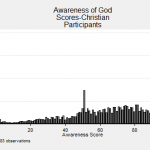I recently came across an article about a lawsuit based on anti-Christian discrimination. I do not know the details of Brandon Jenkins’ case and am willing to wait to see the details of it before passing judgment on the Community College of Baltimore County. I have stated in an earlier blog that those with anti-Christian bias generally do not discriminate against Christians explicitly due to their faith. I stand by that assertion. Yet I am not convinced that the Jenkins lawsuit is a case of “crying wolf.” There are elements in this lawsuit that strike me as a plausible case of anti-religious discrimination. As such, I want to take advantage of this case to further look at how anti-Christian animosity can manifest itself.
According to Mr. Jenkins the only thing he said was that God was the most important thing to him and that statement was in direct response to a question asked to him about what is most important in his life. Additionally, Mr. Jenkins’ letters of reference contain information about his religious faith although the amount of emphasis given to his faith is unknown to those of us who have not seen the letters. In a letter responding to Mr. Jenkins’ inquiry, it was suggested that “this field is not the place for religion.” According to Mr. Jenkins, this was tantamount to religious discrimination as he believes that his Christian faith was part of the reason for his rejection. The administration argues that his religion was not a factor for why he was rejected, but it was the fact that he had an external motivation for pursing this degree. The college prefers that students have an internal motivation driving them to succeed rather than external motivation such as God, one’s family or one’s culture. This type of motivation combined with other possible shortcomings of the student is stated to be the reason for the student’s rejection.
I do not know the details of the case, but it is more believable to me that this may be a case of religious discrimination than the way the atheist professor portrayed religious discrimination in “God’s Not Dead”. It is believable to me that the administrators do not like Christians. My previous work has documented an anti-Christian bias in academia, and mistrust of Christians is likely common among those working in higher education. But those in higher education have a relatively lower willingness to think of themselves as intolerant. Part of their social identity is likely based on the fiction that they are unbiased. So they are inhibited on acting on their religious prejudice unless they can “cover” that prejudice with a nonbigoted reason. An explanation of not desiring students with external motivations can provide such a cover.
In the study of race and ethnicity, there is a theory that helps explain how this happens in a racial context. This theory, known as symbolic racism, is based upon the reality that individuals in contemporary society generally do not want to be seen as racist, but racist feelings and ideas still exist. If a person has racist feelings and ideas, there are sufficient incentives for him/her to hide them. So on issues where there are only racial components, such individuals will exhibit the same attitudes as non-racist individuals. Thus if we ask such individuals whether Hispanic-Americans should be allowed to live wherever they want, then those individuals are likely to reply in the affirmative. To state otherwise is to state an opinion that is clearly racist as this is a question with only racial components. But if such individuals have anti-Hispanic bias then that prejudice can come out in issues with both racial and nonracial components. On immigration issues, that person can argue for tough sanctions since there are non-racist reasons for wanting more control of our borders. The issue of immigration becomes a “symbolic” issue in which those with anti-Hispanic hatred can express that hatred in hidden ways.
Symbolic racism has made it a lot tougher for academics to document the real level of racism in society. Those who use symbolic issues to exhibit their prejudice will not reveal their prejudice except in questions where they can find a non-racial reason for their response. Since we cannot read minds, it becomes impossible for us to determine whether their answers to our questions are driven by animosity or by the non-racist reasoning connected to that answer.
It seems likely that individuals expressing their racism in symbolic ways on political issues would also express that racism in interpersonal relationships or in the course of their daily duties. Thus, I would not be surprised if the same person who uses the issue of immigration to express anti-Hispanic prejudice would also attempt to use his/her institutional power to inhibit the advancement of individual Hispanic-Americans in his/her life if that prejudice can be hidden. For example, if this person is hiring manager of an organization, then he/she may look for reasons not to hire Hispanic-Americans. If a specific Hispanic-American is clearly the best candidate for a position then the hiring manager may have to hire that Hispanic-American or otherwise be exposed as a racist. But in situation where that manager can justify not hiring that Hispanic-American then the manager will use that reason to avoid the hire because of his/her anti-Hispanic bias.
In this light we can see that elements buttressing symbolic racism can apply to expressions of anti-Christian animosity. Those of higher education have more awareness of the social sanctions awaiting those seen as having anti-religious bigotry. Part of their social identity is the belief they are tolerant. Yet anti-Christian animosity among academics is real. One would expect that anti-Christian animosity to most likely be exhibited on issues where that hostility can be hidden by rationales not directly tied to anti-religious prejudice.
One can imagine political and social issues where there are religious and non-religious components. A combination of anti-Christian animosity and the desire to hide that animosity would help us to predict the way individuals who symbolically express that animosity would react to such issues. But consideration of how symbolic hostility may influence issues affecting Christians is a topic for another day. Perhaps in a future blog entry, I will explore one or more of those issues. The Jenkins’ case is more akin to the anti-Hispanic hiring manager who will hire Hispanics if he/she must, but is eager to find “legitimate” reasons to avoid hiring Hispanics. In the Jenkins’ case it is quite possible that some of the administrators have anti-Christian perspectives and see the reason of external justification as a way to symbolically express this animosity.
Of course there is no way to prove that such symbolic hostility is at play. That is the point of expressing animosity on symbolic issues. It allows the perpetrators of hostilities to justify their animosity towards selected out-groups. That is why we cannot prove racism when individuals take political and/or social positions contrary to the interest of people of color, even when we suspect that racism is at play. So if we cannot prove that symbolic hostility then how should we think of the actions of the administrators? I prefer to take people at their word and so when the administrators tell us that they are not motivated by anti-religious prejudice, I want to believe them. However, I also do not want to be naïve. So I ask this simple question: How much has the reason of external versus internal motivation been used in the past to deny students entrance into their program? If there is a clear pattern of rejecting students because they talk about wanting to succeed due to non-religious external motivations such as family, friends etc. then we have more reason to believe the administrators. However, if external motivation is generally only used as it concerns religious motivations then one is well advised to suspect that symbolic hostility is at play. I do not have access to the data that would inform me about the reasoning behind the rejections the college has made in the past, and so I stay agnostic as to whether the Jenkins’ case is the result of anti-Christian bias. However, I cannot dismiss the possible veracity of this situation in the way I did with the movie “God’s Not Dead.”
If the argument of external motivations has only been used to negate the applications of Christian candidates then we can see an important implication of symbolic hostility. Those with anti-Christian hostility have a seemingly non-bigoted reason to discriminate against those with faith. An ideology can be forwarded that external, especially religiously external, motivations are harmful to the potential success of a student. (For the record, I fail to see how external motivations are less valuable than internal motivations but I have not looked into the research on this subject. If internal and external motivations are equally effective in motivating students then there is even more evidence that concern for motivations is not the real reason for rejecting religious candidates.) Of course those who are not religious will not be rejected with such an ideology since they will not utilize religious motivations to justify their application to the program. So even though the rationale of internal motivations seems to be a fair evaluation criterion, the way this rationale is operationalized can have a disproportionate effect on the religious out-groups of the college administrators. This disparate impact is the hallmark of how symbolic hostility operates.
I mentioned in the last blog that it was important for Christians to accurately assess how anti-religious bias may affect them. Too many Christians in the United States are overly eager to make claims of persecution where it does not exist. Movies such as “God’s not Dead” portray an unsophisticated base anti-Christian bias that rarely exists in American society. When Christians create strawmen representations of anti-Christian prejudice, they set up an environment where real Christian prejudice can be masked by the use of measures and rules with a disparate impact on Christians. If we only look for overt expressions of anti-Christian prejudice then more subtle versions of that animosity can easily go unnoticed.
Future details of the Jenkins’ case may tell us if this is a legitimate case of anti-Christian prejudice or if Jenkins is the victim of a rule that may or may not be fair but is not motivated by religious animosity. Nonetheless, it is prudent to keep in mind the symbolic nature of anti-Christian animosity as such cases will continue to come up. Understanding this nature also helps us to see how anti-Christian animosity, and possible bigotry, can play itself out in other situations in our society. Developing a more sophisticated understanding of that animosity is a better way to combat this anti-religion intolerance than overhyping an image of a crude prejudice that rarely exists.















